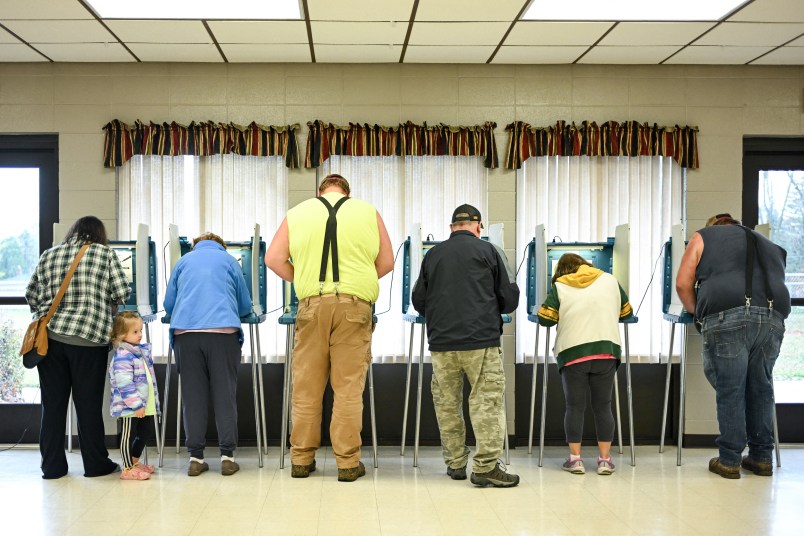I got this note from TPM Reader BF and I thought I’d share it with you and also share some thoughts of my own.
I think what sets a lot of people off about your approach is just how divorced it seems to many of us from reality. You are arguing from the position that the Democratic party is basically healthy, and just needs some tactical tweaks. Many of the rest of us see a party in steep decline that has no idea how to deal with GOP radicalism. It’s not that responses need to be more bold, but they do need to address the broader structural issues that have led to the doleful position which the Democratic party finds itself today: irrelevant in much of the country, devoid of virtually any rising leaders, and always on the defensive.
The problem is that you’re thinking tactically. The structural problem, though, is deeper, and until Democrats get at the structural problem, even tactical solutions will fail most of the time.
The analogy I think is appropriate is that the Democrats are like a sports team that has had recent success and keeps trying to squeeze out just one more ring with the cast of veterans they have on the team. But there are times when you need to tear things down in order to build. So a few thoughts:
1) The Democrats have singularly failed over the past decade to develop a strong bench and new talent. The party is geriatric and wheezing. There needs to be a concerted effort to develop the next generation.
2) Democrats need to rebuild their base and their ability to act locally. I am not sure you’re viscerally aware of how much ground Democrats have lost at the local level. But even in the DC suburb where I live, ALL of the energy and initiative is on the GOP side. We’re completely reactive and a step behind.
3) Democrats need to build national networks of political activism focused on issues people are passionate about. We have no equivalent to the Federalist society. No equivalent to the NRA. No equivalent to the Evangelical movement. In terms of activism, the problem is that many, many of us — cishet, white — are in a supporting role. And I get it. The challenges facing Black Americans, LGBTQ folks, etc. are huge, and we do need to support equality and equity. But if all you can be in the Democratic party is an “ally,” it creates an imbalance of passion. I support Democrats out of empathy, but aside from climate change, the way in which the Democrats propose to make MY life better is largely through the amorphous (though important) promise in a better, more just society.
4) Democrats need a generational strategy going forward. That is what is sometimes frustrating about your advocacy. Supporting Biden in the primaries was fine, but it was completely short-term. It just helped get Trump out of office. That’s important, no doubt. But Biden’s inability to connect and rally support was predictable. He’s old and tired. His ideas are old and tired. He’s a decent man, and maybe getting rid of Trump was so important that it was worth mortgaging the future. But let’s be honest, that’s what we did in 2020. But the point is, we can’t just focus on the 2022 election. What does the Democratic Party look like in 2028? 2032? 2040? What are its core constituencies? Its core positions? What does the Democratic Party stand for aside from being anti-GOP?
5) The unwillingness of the Dems to take short-term wins is fucking maddening. Pass cannabis legalization. Codify a commitment to protecting people with pre-existing conditions rather than waiting for ACA to be finally repealed or overturned (because, yes, that will happen). Take a stance on crime — more federal dollars linked to a ban on military hardware and an end to civil forfeitures.
6) Finally, Democrats have to stop engaging in wishful thinking about the GOP “going too far.” That might happen, but that’s not a strategy. That’s just wishcasting.
I think all of us like to flatter ourselves that we’re operating at the level of strategy while everyone else is stuck down in the short-term weeds of tactics. I’m sure the same applies to me. But with that said, I think BF doesn’t really grasp the thinking behind what I’ve proposed about framing the 2022 midterm around reversing the Court’s reversal of Roe. First, though, I wanted to note that BF’s email shares a feature common to many similar totalizing and expansive critiques of the Democratic party and liberal politics. If you look at BF‘s list he doesn’t actually propose anything. He lists off a series of challenges that are close to universally agreed upon by Democrats and says they need to be solved: a better bench, more effective local organizing, better activist groups, a generational strategy. But an agitated recitation of various structural problems isn’t a strategy. Saying “we need a strategy” isn’t a strategy.
I think BF imagines that while the Democratic house is burning I’m proposing a test vote that probably won’t happen in any case. So that just shows I have not concept of the scale of the problem. But what I am prescribing very much is a strategic shift. I think reproductive rights are extremely important and I’m pushing this approach because it’s actually the only plausible strategy for saving access to abortion services around the country. But it’s not only that. It’s also the one big cudgel that has fallen into the Democrats’ hands that holds some prospect of reversing or at least blunting the brutal electoral tide. These two things fit together. It’s not one or the other. And it’s the connecting of the two, with clarity, where Democrats often miss out.
The great enemy in politics is opacity, the general sense that politics doesn’t work but the unclarity about just how it doesn’t, who’s standing in the way or specifically what actions could drive change. Back almost two decades ago when President Bush tried to phase out Social Security it seemed like the ground was falling out from under Democrats because it was so hard to see how to put up a defense. Some unknown number of Democrats were going to compromise rather than flatly oppose but just who they were was unclear — and by design. The key ended up being that it wasn’t enough to denounce what was happening. It was critical to pierce the secrecy of the congressional caucuses and see just where each particular member stood. If everyone was united in opposition it would never happen. This was a clear theory of the case. You could focus attention in on the diminishing number of hold outs and move them.
The particulars of that legislative moment aren’t the point. What’s critical is aligning people’s energy and anger with a clear path of action. There’s a vast body of scientific literature about experiments in which animals are habituated to learn that their actions have no impact on the world around them. They learn the patterns but it doesn’t matter. They learn the schedule but then it randomly changes. Those animals get depressed, hypertensive. They get sick. Our inner balance and internal life is heavily dependent on some relationship between our desires, fears and actions on the one hand and the world outside us on the other. That doesn’t mean the world outside us is to our liking necessarily. The key is that it needs to have some predictability to it and there needs to be some relationship between our actions and that world around us.
People are upset and angry right now not only for the obvious reason that half the population is about to lose what we’ve enjoyed as a fundamental right for half a century. It is compounded because it’s not clear what anyone can do about it. And it’s come to this pass because of a stolen Supreme Court seat, the random chance of the death of a Justice in the fading months of Trump’s corrupt presidency. In fact there is something people can do. If Democrats hold the House and expand their Senate majority with two seats they can pass a law that reverses this. You already have 49 votes for the law. You probably have 48 for the filibuster change. But get everyone on the record now. Get everyone to commit to specifics. In this political climate those wins are a huge, huge challenge. But it’s not impossible. It doesn’t require heroic assumptions.
To me morale and clear wirings of political actions to electoral and policy outcomes are vital to a political movement. They tend to be what drives building candidate benches, powerful political advocacy groups and more. Politics operates through group dynamics much as armies and sports teams do.
Democrats seem to be hoping that Roe will galvanize voters toward the Democrats because Democrats support Roe and Republicans do not. I don’t think that’s enough. I think you need to put something concrete and specific on the table, with votes already lined up. If you don’t get those two seats it’s still better because you had clarity about what it was going to take and you have clarity about what it will take two years later. You have clarity in 2024 that you need a Democratic president. Doing a test vote now with 49 votes, I really have no idea what that even means. A system in which 49 votes doesn’t matter because 50 or 55 votes don’t matter either is one that is poisonous to any vision of good governance let alone progressive governance. It’s like taking your remote control toy car out to play with after you cut it’s wires and then being surprised it doesn’t move. Of course it doesn’t move. The wires aren’t connected.
I want Democrats to connect the wires. Clarity is key to morale and morale is the taproot of party strength. People invest themselves when there are demonstrated links between effort and outcome.







